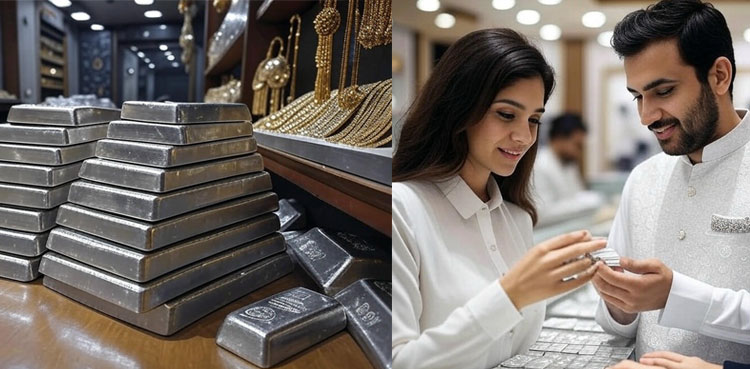Karachi, May 6, 2025 – The latest silver rates in Pakistan, as reported by the Karachi Sarafa Market, show 24K silver priced at Rs. 3425.00 per tola, Rs. 2936.40 for 10 grams, and Rs. 293.64 per gram.
These figures reflect the current trends in the precious metals market, driven by global economic factors, currency fluctuations, and local demand. Silver, often overshadowed by gold, remains a critical asset for investors, jewelers, and households in Pakistan, and these rates signal important economic insights.
Current Silver Rates in Pakistan
- 1 Tola (24K Silver): Rs. 3425.00
- 10 Grams (24K Silver): Rs. 2936.40
- 1 Gram (24K Silver): Rs. 293.64
These prices are for 24K silver, the purest form, widely traded in cities like Karachi, Lahore, Islamabad, and Multan. Compared to recent months, silver rates have shown moderate fluctuations, influenced by international market dynamics and the Pakistani rupee’s performance against the US dollar.
Why Silver Rates Matter in Pakistan
Silver holds a unique position in Pakistan’s economy and culture. Unlike gold, which is often seen as a luxury investment, silver is more accessible, making it a popular choice for jewelry, household items, and small-scale investments. Here’s why silver rates are significant:
- Affordable Investment Option: With gold prices soaring (1 tola gold at Rs. 353,500 as of May 4, 2025), silver offers a cost-effective alternative for investors. At Rs. 3425 per tola, silver is roughly 100 times cheaper than gold, attracting middle-class buyers and small investors.
- Cultural and Industrial Demand: Silver is extensively used in jewelry, religious artifacts, and industrial applications like electronics and solar panels. Stable or rising silver prices can indicate strong demand in these sectors, reflecting economic activity.
- Economic Indicator: Silver prices are closely tied to global commodity markets and currency values. A weaker Pakistani rupee against the US dollar, as seen in recent years, drives up silver prices locally, signaling inflationary pressures or economic instability.
- Hedge Against Inflation: Like gold, silver is considered a safe-haven asset. Investors turn to silver during times of economic uncertainty, such as political instability or global market volatility, to protect their wealth.
Impact of Current Silver Rates
The current silver rates, hovering around Rs. 3425 per tola, have several implications for Pakistan’s economy and its citizens:
- Jewelry Market: Higher silver prices may increase the cost of silver jewelry, a staple in Pakistani weddings and cultural events. Jewelers may pass on these costs to consumers, potentially dampening demand among price-sensitive buyers.
- Investor Behavior: The relatively stable silver prices compared to gold’s volatility may encourage investors to diversify their portfolios. Silver’s affordability makes it an attractive option for those looking to hedge against inflation without committing large sums.
- Industrial Costs: Rising silver prices could increase production costs for industries relying on silver, such as electronics and renewable energy. This may lead to higher prices for consumer goods or slower adoption of technologies like solar panels.
- Rural Economy: In rural Pakistan, where silver is often used as a store of wealth, price increases can boost the value of household savings. However, it may also make it harder for families to purchase silver for traditional purposes like dowry or gifting.
What Do Silver Rates Indicate?
Silver rates are a barometer of both local and global economic conditions. The current prices suggest:
- Global Market Influence: Silver prices are set by the London Bullion Market Association and influenced by global supply and demand. The steady rates indicate balanced global demand, possibly driven by industrial needs and investment interest.
- Currency Fluctuations: The Pakistani rupee’s depreciation against the US dollar continues to push silver prices higher locally. This reflects broader economic challenges, including trade imbalances and foreign exchange reserves.
- Economic Sentiment: Stable silver prices amidst global uncertainties (e.g., geopolitical tensions or US dollar strength) suggest cautious optimism among investors. However, any sharp spike could signal a flight to safe-haven assets.
Historical Context and Trends
Over the past year, silver prices in Pakistan have risen by approximately 20-25%, driven by global commodity trends and local currency weakening. For instance, on December 31, 2024, 1 tola silver was priced at Rs. 3070, and by March 1, 2025, it reached Rs. 3509, showing a steady upward trend. The current rate of Rs. 3425 indicates a slight correction, possibly due to stabilized global silver supply or reduced speculative trading.
Expert Insights
“Silver remains a vital asset in Pakistan, especially for those who can’t afford gold,” says Ahmed Raza, a Karachi-based bullion trader. “The current rates are sustainable, but if the rupee weakens further or global demand for silver in industries like solar energy spikes, we could see prices cross Rs. 4000 per tola by mid-2025.”
Economists also point out that silver’s affordability makes it a bellwether for middle-class economic health. “When silver prices rise too quickly, it can strain household budgets, especially in rural areas where silver is a traditional savings vehicle,” notes Dr. Sana Malik, an economist at the University of Karachi.


Leave a Comment